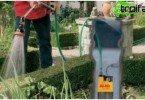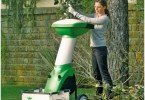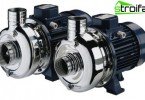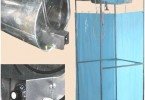For owners of private houses, cottages, to which a personal plot adjoins, a shearing, shaving or mowing device is an essential item. Understand how to choose a lawn mower, they must be sure. The choice of such mechanisms is quite wide, the principle of operation varies. Before proceeding to specific recommendations, it makes sense to dwell on classification points.
Content
- Instructions for choosing a mower
- What happens this technique
- Electric Lawn Mowers: Pros and Cons
- Gasoline lawn mowers: positive and negative
- What to choose: electric or petrol unit
What happens this technique
To put in order the stormy garden and cottage vegetation, not too complicated types of mechanical and cordless tools are used, as well as the gas-lawn wheel constructions proper: gasoline and electric. The most simple, manual ones include electric trimmers (used to cut fishing line in places remote and inaccessible, under trees) and scythes (designed to cut large irregular areas with thick weeds and burdocks by fishing line and knives).
The trimmer is eco-friendly, lightweight and quick-witted. It cuts well where the lawnmower does not turn around, works quietly, regularly overcoming a shallow relief. You won’t be able to walk along the humid field (after all, an electrical appliance), and it’s small in power (the “extreme” numbers are 250 and 1300 W). He will not let go far from home: the length of the extension cord decides the matter. There is a battery option, it is heavier. Motokosa is clearly more productive, more convenient to use. Shears not only grass, but small reed bushes. It works for a long time, but requires refueling (oil), it makes a lot of noise and vibrates. Not everyone will cope with it.
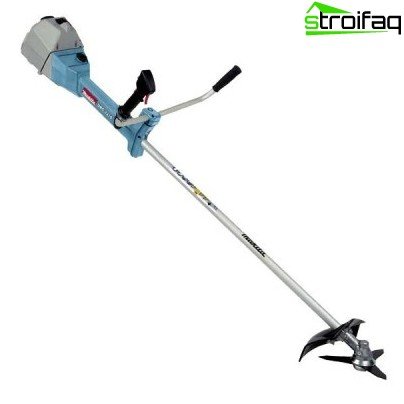
The petrol trimmer is convenient for processing “back streets” and platforms under trees
In part, we have already answered the question of how to choose a lawn mower – it’s nice to have any of the described devices (trimmer-motocosa) on the farm: for hilly and remote places. Their advantages: low cost, simplicity, mobility. But for a large flat area you still need a more solid tool, resembling a cart on wheels – the lawnmower itself. None of the models will take grass to the waist, but it will provide a relatively quick processing of a decent size site. It remains only to determine the type of engine of such special equipment: it will be electric or gasoline. We will describe them separately.
Electric Lawn Mowers: Pros and Cons
An electric device with complex construction on wheels is more powerful than the above-described manual varieties of lightweight agricultural machinery (900-1800 W). It can function for quite a long time, it is managed without difficulty (a woman, an elderly person will “obey” without problems). It is eco-friendly, leaves a row even, cuts plants accurately, at a height of from 20 to 75 mm. Usually equipped with a grass catcher. However, it is capable of moving only on level ground and is powerless against tall grass. The cable length will be a deterrent: the mower will not be able to move away from the power source by more than 20 meters. Wet lawn without rubber boots is generally dangerous to mow.
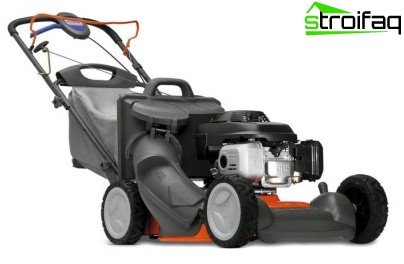
Among electric lawnmowers, quite powerful models are found
Gasoline lawn mowers: positive and negative
These are high-power devices (within 5-7 hp = 250 W), and therefore more productive. They cover a large area perfectly, more reliable and maneuverable than electric ones (no wires). Autonomy is excellent quality, but the buzz with the engine running is such that sometimes you need headphones (so as not to lose your hearing). They are often even included. The “machine” itself weighs a lot, it also eats a lot of expensive fuel, however, it can work more than one hour in a row – just to add oil on time. There are models with a two- and four-stroke engine. It is technically more difficult to maintain than an electric unit, it is expensive, it creates a cloud of exhaust gases, but it is able to “mow” 10 acres and more.
Motokosa saves fuel, but does an excellent job
What to choose: electric or petrol unit
When deciding on the choice of a lawn mower in favor of a gasoline or electric option, one must take into account criteria such as power-noise-performance-safety and not forget about the control availability, weight, maneuverability and service conditions of both types of mowers. For very large areas, a gasoline engine is better: it is more powerful and lasts longer. But the prices for such a “product” are higher, and not everyone will quickly get the hang of a “horse”. Such a self-propelled cart and a young shrub, and a tree shoot will cut it. The working width is impressive (from 37 to 53 cm). But the fascination with heavy-duty models is fraught with trouble: their willingness to engage in battle with the stones ends with the curvature of the shaft, knives – and overhaul.
Unlike gas-powered “strong men”, more “delicate” electric mowing devices have difficulties not only with stones – they will also be confused by an unfinished dog bone. Having stumbled upon an obstacle, the mower stops, stalls. But the knives and bushings will remain intact. The stone will not be thrown for long – and the process will continue. In this regard, the technique is less impressive more profitable: less often it fails. And such a device does not need special control: it does not require oil-gasoline. This is “on hand” for those who do not like to mess with equipment or are poorly versed in it. Well, the fact that the current-powered device is “lightweight” in comparison with a super-heavy gasoline engine and without pressure unfolds, gives people physically weak access to the haircut process.
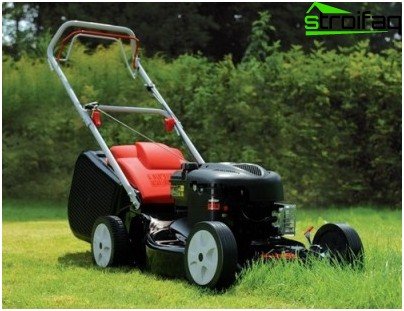
Powerful lawn mowers on wheels are good for handling large, flat areas
Regarding safety (both a person and his “assistant”), the options are approximately equal. Which is better: breathing gas vapors, stalling from the roar of the engine, or being afraid of electric shock in wet weather or accidental “collision” with the cord – it’s up to you. In the end, rubber shoes will relieve such discomfort. Much more inconvenience creates the ability of the sample to overheat every 15-20 minutes, which is why it is necessary to suspend mowing. The pace goes astray, it takes more time to mow. In addition, the length of the cord is embarrassing. Buying an extension cord is expensive: the “mower + automation + cable” kit is almost equal to a gasoline device at a price. There is something to think about..
However, when deciding which electric lawnmower to choose – as well as a gasoline one, a system with an overhead motor might be a good defense: in this case, it will not react to wet grass and electric injury will be practically eliminated. Now it’s clear why much more powerful (400-1500 W) models are produced with the top connection. For a relatively flat, peeled from pebbles plot of a garden-lawn-lawn of 5 acres, such an acquisition will probably become a wise option. By the way, two types of drives are distinguished in a gasoline unit: front and rear. The front makes driving easier: it is easier to turn around in place with the engine turned on. True, if the grass is wet, the car is skidding, it must be pushed. The rear-wheel drive version does not slip, but you have to turn off the drive when cornering.
General model selection criteria
Imagine this situation: you have already decided the problem with the type of technique for cutting and trimming the stems – it remains to decide on a specific sample of your future “assistant”. At this stage, regardless of which lawn mower you decide to choose – gasoline or electric – it will be useful for you to recall the additional functions and features common to both lines. We will name the most typical of them:
- type of grass catcher;
- mulching;
- wheel problem;
- case material;
- engine.
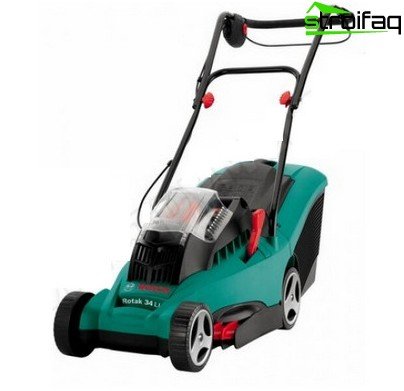
Expensive battery models are structurally reminiscent of electric ones, but they are much more mobile
The grass catcher is useful when in the final you don’t feel like messing with the cut and scattered grass (or it interferes). Such a device leaves behind a clean, neat lawn, but the grass must be periodically unloaded from a soft or hard container. Soft (mesh, fabric) is convenient because it is easy to track the degree of filling: the bag becomes heavier and stops bloating. It is impossible to trace the filling of solid. The fabric option also has disadvantages: it quickly clogs, especially if the grass is wet. As a result, you have to wash or vacuum the net.
Mulching (grinding) allows you to not remove the cut, leaving a “trifle” for feeding. The operation is meaningful only if the grass is dry. In the opposite case, such actions not only do not bring benefits, but even harm: the grass section sticks together – and lumps lie on the ground, clogging the growth of fresh shoots. The dry layer also cannot be left constantly – this ends with the growth of so-called “felt turf” on the soil. The lawn becomes so untidy that subsequently there is a need for combing. It’s great if there is a lateral outburst: this creates the conditions for obkoski roadsides.
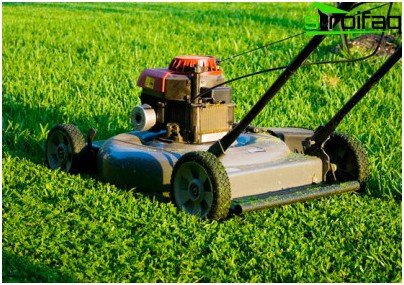
Powerful lawn mowers on wheels are good for handling large, flat areas
The width of the wheels and their diameter are directly related to the ability to capture high grass, the speed of passage and the depth of the traces left. The wider the wheel, the less it will jam the grass. The larger the diameter, the more adapted the device for mowing “high thickets”. The more impressive the width of the grip, the faster you will be able to go through the entire section. Actually, the speed directly depends on the power and characteristics of the engine. It is quite obvious that branded engines function better, and there are no complications with spare parts for them. As for the case material, there is no doubt: any metal “suit” is more durable than plastic.
To summarize the above, we recall:
- the design of the mower is determined by the terrain and the condition of the mowed green cover;
- the mower is selected depending on the area in need of processing, physical and material capabilities;
- any model will be effective if the criteria are taken into account when choosing, and the tool is used correctly.


